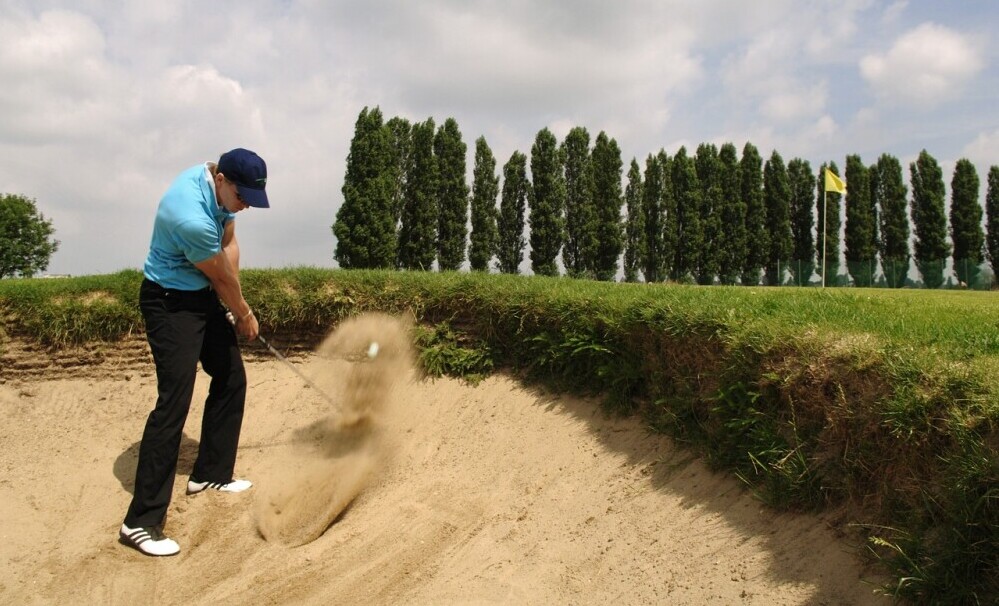Golf Strategies And Tactics


Fore! Quick note: a few links here are affiliate links. If you snag gear through them, I earn a small commission — no extra strokes added to your game.
Understanding the foundational strategies and tactics is key for anyone picking up golf. It’s not just about hitting the ball; it’s about hitting it with purpose. It’s about avoiding the hazards that the course presents to you and putting your ball in the best position to get to the hole. Grasping the basics will set you up for success on the course. The golf viking is here to help you hit the course with the best strategies to win.
First things first, let’s talk grip, stance, and posture. A solid grip ensures control and power during your swing. Focus on a neutral grip that isn’t too tight or too loose. Your stance should be shoulder-width apart for balance, and a slight knee bend helps with stability. Posture is crucial—keep your back straight but relaxed, and tilt from your hips, not your waist, to avoid unnecessary strain. These will be the first things you will want to get down. Without a good swing, you will have a tough time being successful on the golf course.
Club selection can feel like a guessing game at times, but it doesn’t have to be. Beginners should start with a few versatile clubs—a driver, a couple of irons (like a 7-iron and a 9-iron), a wedge, and a putter. As you get more comfortable, you’ll learn when and why to use each club based on distance and the type of shot you need to make. As you get more experienced you will want to add the various wedges and hybrids to your golf bag. A big part of being a good golfer is knowing your shot well enough to know which club to use for each situation you may find yourself.
Understanding the layout of a golf course can dramatically improve your game. Each hole is designed with a specific trajectory in mind. Study the course map before you play, noting where the hazards, such as bunkers and water, are located. Plotting out your shots in advance helps you avoid trouble spots and lowers your score. Once you have your swing down and you know which clubs to use at the right time, you will begin to plan out how to attack the course in which you are playing. Study the hole layout and hit your ball in the best spots to get to the green, all while avoiding the hazards.
Learning these fundamentals not only boosts your confidence but also builds a strong foundation. With these basics down, you’ll navigate the fairway smoother and start thinking more strategically about every shot. So grab your clubs, head to the range, and give these tips a try!
Good strategy starts with understanding your swing and equipment. See our guide on mastering the golf swing to make better tactical decisions on every hole.
Ready to level up your golf game? Click here.

Navigating the Course: Strategic Movement and Shot Placement
When you step onto the golf course, every shot should have a purpose. Playing strategically means thinking several steps ahead and understanding how each shot sets up the next one. This isn’t just about power; it’s about precision and foresight. When you know the layout of the hole, you will figure out where you want to hit your ball to get the best lie.
One key tactic is to always have a plan for your round. Before teeing off, visualize each hole from start to finish. Identify the safe zones where you want your ball to land and the risky areas you need to avoid. This mental mapping helps you stay focused and make informed decisions on the spot. Always have a ‘Plan B’ for when things don’t go exactly as planned.
Positioning your ball effectively is crucial. For example, aiming for the center of the fairway might give you a better angle for your next shot, even if it means sacrificing a bit of distance. Also, think about the pin placement on the green—sometimes aiming for the fat part of the green is safer than going pin-hunting and risking a bunker or rough. I would recommend starting out more conservatively with your shots, then as you gain experience you may try taking riskier shots that require more accuracy.
Different terrains present unique challenges. Whether you’re dealing with an uphill lie, downhill lie, or sidehill lie, adjusting your stance and swing to match the terrain can make a world of difference. A good rule of thumb: play the ball more towards your higher foot to help counteract the slope and maintain balance. Every course is different, and that’s the challenge(and the fun) that golf presents.
Managing hazards is part of moving strategically. If a water hazard or bunker is in play, plan your shot to land short or aim for a wider part of the fairway. It’s always smarter to play safe and take an extra shot than to risk a penalty stroke or a tricky recovery. Hitting your ball into a hazard can really add strokes to your scorecard, so I recommend strategizing your game to avoid them when possible.
Finally, practice makes perfect. Spend time on the practice range working on shot placement from various distances and lies. The more you familiarize yourself with different scenarios, the better prepared you’ll be on the course. Strategic movement and shot placement aren’t about luck—they’re skills you can develop with intention and practice.
Course management is key. Learn more about navigating hazards in what is a bunker in golf? and how to approach tricky lies.

Choosing Wisely: Club Selection Strategies
Your golf game can be made or broken by the clubs you choose for each situation. The right club can turn a good shot into a great one, while the wrong choice can lead to trouble. A systematic approach to club selection is a game-changer.
First off, yardage is king. Accurately gauging the distance to your target will inform your club choice. Many golfers rely on rangefinders or GPS devices to get precise yardages. Knowing how far you hit each club on average is vital here. If you’re unsure, spend some time on the driving range to get those numbers dialed in. This will really help you judge what club you will need to get to the green in the least amount of shots.
Wind conditions can significantly affect your club choice. A strong headwind might necessitate a club with more distance, while a tailwind could mean clubbing down. Crosswinds require adjustments in aim—line up to allow the wind to bring your ball back on course. With high winds it may be more beneficial to hit the ball low rather than high into the air, otherwise known as a punch shot. For more on how to play in the wind, click here.
When considering which club to use, think about the lie of your ball too. A tight fairway lie suggests a different approach than a fluffy rough. Generally, harder surfaces require a lower-lofted club, while softer lies might need more loft to get the ball airborne effectively.
Risk and reward also play a part. For example, going for the green in two on a par-5 might seem enticing, but weigh the risk of landing in hazards or tough lies. Sometimes laying up with a safer club sets you up for a more manageable approach shot. Hitting a hazard can make you pay dearly, so choose your shot wisely.
Don’t overlook the value of data and technology. Many modern clubs come with tracking systems that provide feedback on your performance. This data can help you make more informed choices on the course. Apps and software can also analyze your swing and suggest optimal club selections for different scenarios.
Knowing which club to use sets the foundation for any tactic. Check out our post on how to know what club to use in golf for club selection strategies.

Overcoming Obstacles: Effective Strategies for Hazards
No round of golf is complete without facing some hazards, but knowing how to manage these obstacles can save strokes and your sanity. It’s about keeping a cool head and applying the right tactics to navigate sand traps, water features, and penalty areas with confidence.
When you find your ball in a bunker, technique is your best friend. Position the ball slightly forward in your stance, open the clubface, and focus on hitting the sand, not the ball. This helps lift the ball out smoothly with enough loft to clear the lip. Don’t rush—take a practice swing or two to gauge the feel of the sand. Knowing how to effectively get your ball out of a bunker can help save you from what could have been a bad score.
Water hazards can be particularly daunting, but careful planning makes a big difference. Aim to land your ball safely away from the water, even if it means playing more conservatively. If the water’s unavoidable, make sure you know the rules for penalty drops. Sometimes a well-placed drop can still set you up for a decent recovery shot. But ideally keep your ball dry!
Roughs and difficult lies demand creativity and smart shot-making. When faced with a thick rough, grip the club a bit tighter and make a more aggressive swing to power through the grass. For awkward lies, adjust your stance to match the ball’s position—play it forward for uphill lies and back for downhill. Remember, sometimes just getting the ball back into a favorable position is the best strategy. Sometimes you will get yourself in a bad position on the course, but knowing how to get out of it can save you from compounding your mistakes.
Penalty areas need strategic thinking. Know your options, such as taking a penalty drop instead of trying a risky shot that could result in a worse situation. Understanding the rules helps you make quick decisions to keep your game on track. Know what the rules are for balls that are unplayable.
Keeping your mental game strong is crucial. Hazards can be intimidating, but staying positive and focused will help you execute your escape plans. Visualize your target, trust your swing, and don’t let one bad shot spiral into a series of mistakes. Every golfer faces hazards—handling them well is what sets the good players apart from the great ones.
Understanding distance control is critical for effective strategy. Review our post on the best golf exercises for distance to combine fitness with smarter play.

Sealing the Deal: Putting Strategies for a Strong Finish
When it comes down to it, putting can make or break your score. It’s where precision meets finesse, and every stroke matters. Mastering your putting game means paying close attention to the details and making small adjustments that can lead to big improvements. Putting well can save you from a tough hole.
Start by positioning your ball correctly for an optimal putt. Before every putt, take a moment to read the green. Look at the slope, grain, and any visible imperfections. Place your ball where you can make a straight shot or a gentle curve, avoiding tricky spots whenever possible. Hitting your ball into a slope can be dangerous and roll off of the green, so be careful with your putt. Sometimes it may be better to get close to the hole, rather than put your ball in a position where it can roll away from it.
Reading the greens is an art form. Squat down to get eye-level with your target line, and use your putter to gauge the slope and break. Imagine a line from your ball to the hole and visualize the path it needs to take. Practice green-reading techniques regularly to develop your intuition. Every golfer has their own routine when it comes to reading greens, but basically you will need to factor in the slope and speed of the green.
Accuracy and consistency in putting require dedication. Keep your stroke smooth and steady, and maintain a light grip to avoid tension. Focus on making a pendulum motion with your arms and shoulders, rather than your wrists. Consistent practice helps ingrain these habits, making you more reliable under pressure.
Environmental factors like wind, rain, and changing light conditions can impact your putting. Wind may require you to adjust your aim slightly. In wet conditions, the green slows down the roll, so hit the ball a bit firmer. As daylight fades, shadows can affect your perception, so trust your initial read even more.
Remember, the mental aspect of putting can’t be overstated. Stay calm, trust your preparation, and don’t overthink. Developing a pre-putt routine helps with focus and reduces anxiety. Whether it’s a few deep breaths or a specific number of practice swings, find a routine that works and stick with it. Well I hope that these tips will help you improve your scorecard and beat all of your friends as well. I’ll see you out on the golf course, golf maestros.
Mental focus and course awareness also affect tactics. Learn more in the role of mental focus in golf to stay sharp under pressure.


